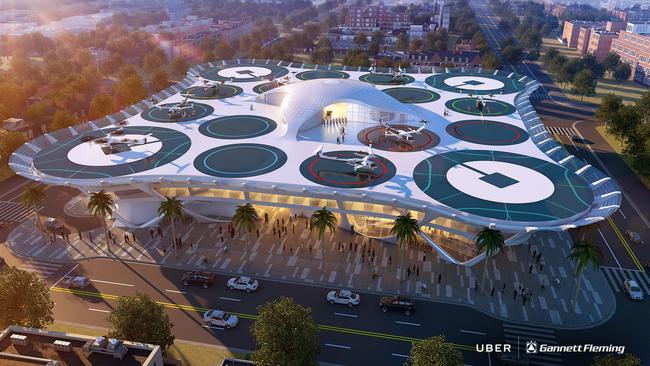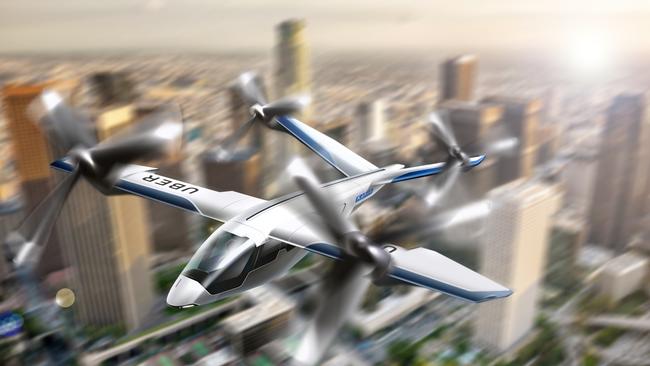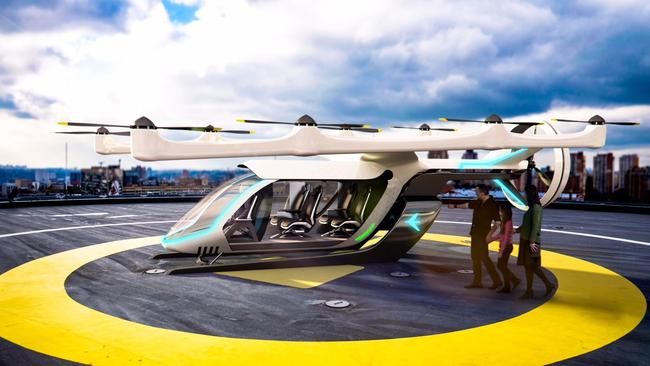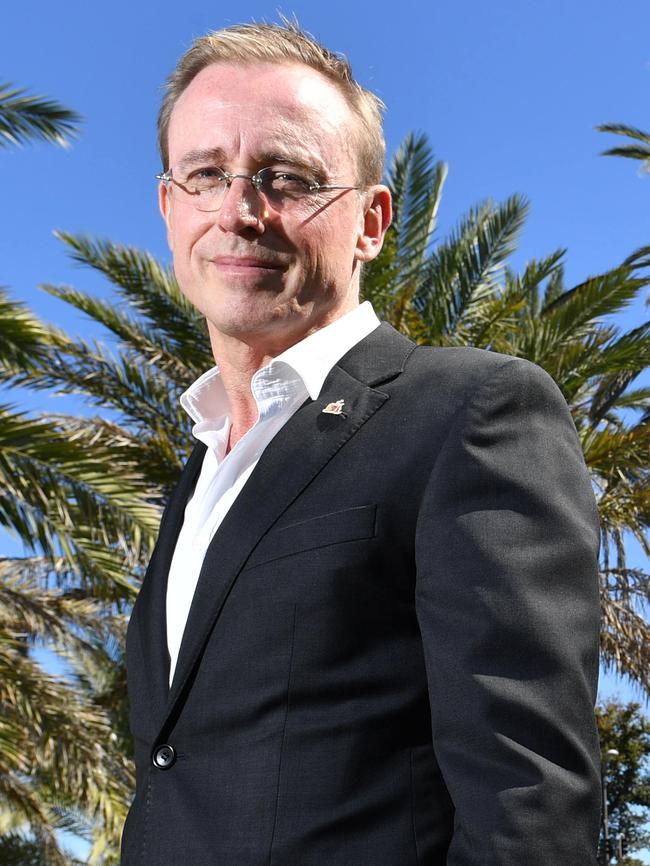Review of state’s transport strategy as driverless cars and Uber drones to the airport emerge as a reality
A DRIVERLESS drone takes you to the airport. A driverless bus carries you to work. You charge your electric car at the weekend. This isn’t just Adelaide’s future — it’s already happening. And the state has to plan for it.
- FOR MORE FUTURE ADELAIDE CLICK HERE
- Free city Wi-Fi on the fast track
- Adelaide’s top 10 suburbs to live, work and play
- How to capitalise on Adelaide’s of $90bn shipbuilding program
- The key to Port Adelaide’s future may be in its past
- Bring the Formula E race to Adelaide
- Revealed: Bold bid for KI bridge
THE State Government has ordered a comprehensive review of the state’s transport planning strategy to cope with rapidly changing technology.
Transport and Planning Minister Stephan Knoll said the state’s Integrated Transport and Land Use Plan released in 2015 had already been rendered obsolete, especially when meeting the challenges of driverless vehicles, electric vehicles — which are expected to make up half the fleet within 20 years — and meeting the challenges of the $90 billion Federal Government defence contract spending in Port Adelaide.
Mr Knoll commented as rideshare giant Uber told The Advertiser that it planned to have Uber Elevate — drones which would first operate from airports to the CBD — established in Australian capitals within five years.

“We are going ahead with an update for the state transport plan,’’ Mr Knoll said.
And he said the Federal Government must plan for a user-pays system for electric vehicles to compensate fossil-fuel car owners for the 40 cents/litre they pay in fuel tax.
Mr Knoll repeated the State Government’s commitment to have no toll roads in the new transport plan, but said there had to be a “discussion” about how electric cars would in future contribute to road construction and maintenance.
“So at the moment everyone pays for the roads through fuel excise. They pay at the bowser, but with electric vehicles you won’t do that,” he said.
Freight Council of SA spokesman Evan Knapp said the updated plan should accommodate the likelihood that freight would be one of the early adopters of driverless technology.
“There are already driverless freight trains operating in the Pilbara region and we expect long-haul road freight — but not in urban areas — is not far away in Australia,’’ he said.
Mr Knapp said planning must also address the long-term underfunding of SA road infrastructure.
Mr Knoll said that driverless vehicles, which through Flinders University are already operating on SA public roads, would be one of the biggest transport challenges for the state to meet.
Mr Knoll said he expected public transport and freight transport to be the earliest adopters of driverless vehicles, but the transformation would begin with town planning, starting from now onwards.
Adelaide Lord Mayor Martin Haese said there must be a co-ordinated effort between federal, state and local government. He said the City Council “smart move” policy was also being reviewed.
The need for a new SA Integrated Transport and Land Use Plan is a key finding of the PwC report commissioned by The Advertiser — CityPulse Adelaide, which aims to help planners make the most of the city’s development opportunities.
It found: “South Australia’s current Integrated Transport and Land Use Plan … was released in 2015, there is value in revisiting it to fully consider the impact of the future shipbuilding program and the potential population growth for Adelaide’’.
Mr Knoll said he’d already spoken with Federal Minister for Defence Industry Christopher Pyne about Port Adelaide infrastructure needing to cope with 8000-10,000 extra local jobs through new defence contracts.
The PwC report predicts within two years around 4000 workers are expected to move into the Lefevre Peninsula area, putting a strain on roads, rail, buses, schools and hospitals.
RAA spokesman Mark Borlace said a priority for the state’s transport plan should be to start using so-called Intelligent Transport System data from the road and rail network to make more informed planning decisions and give motorists real-time information to help them on the road.
Civil Contractors Federation spokesman Phil Sutherland said a focus of the government must be fast-tracking the pipeline of infrastructure projects to aid the construction industry in the wake of the York Civil collapse.
“I’ve heard there are only three small projects to be sped up in the State Budget, and they have put a lot of faith in their Infrastructure SA to be a clearing house, but they’d better get their skates on or they won’t have to cut many ribbons by the next State Election,’’ Mr Sutherland said.
“The Adelaide road network is 30 to 40 years out of date, and we can talk about electric cars and driverless cars but they all still need roads.’’
It’s up, up and away as Uber dreams of drones to the airport
MEET George Jetson; well Uber want to introduce Adelaide commuters to the cartoon character’s hovering “car” at least, and all within the next five years.
The world’s biggest ride share company — after putting driverless vehicles on hold following a fatal accident in the US this year — is now focused on small electric drones.
Uber spokeswoman Megan Smith said the global Uber Elevate program was seeking an Australian city to be the third in the world to trial the scheme.

“You can only imagine the positive impact this would have for Adelaideans, Melburnians and Sydneysiders not having to waste hours stuck in traffic every day,’’ she said.
“Our Uber Elevate initiative is unlocking the future for how urban aviation ride-sharing will help cities become smarter, better and more efficient.
“On-demand aviation has the potential to radically improve urban mobility, giving people back time lost in their daily commutes.’’

Pilotless drones are already operating in Dubai between the city’s airport and high-rise helipads, but Ms Smith said Uber Elevate would use drones crewed by helicopter pilots to begin with and then driverless.
The Uber drones have been made possible because of rapidly improving battery and lightweight electric motor technology which have become popular in ground-controlled drones.
Adelaide Lord Mayor Martin Haese said the interest shown by Uber in Adelaide backed the council’s efforts to be a leader in electric vehicle friendliness and he would “engage” with the company about the concept.

“We have been proactive in rolling out electric vehicle charging infrastructure, and we are ahead of the curve with 40 charging stations throughout the city,” Mr Haese said.
“I think, like a lot of people, I see the Uber plans as mildly scary but quite exciting.
“This is the most fundamental change in history in terms of transport planning. Transport has had incremental improvements since the invention of the internal combustion engine but what we are talking about now is a paradigm change, sending us down the path to autonomous vehicles.

“We’d love to engage with Uber in the suggestion.’’
RAA spokesman Mark Borlace said drones and even pilotless drones were in the serious planning stages in more congested cities.
“I know they are getting serious about it in Dubai and places like that, but I think not just yet in Adelaide,’’ he said.
“But what you learn in this area is the future comes much quicker than you thought, so five years may be not a bad prediction.’’
— Miles Kemp
Free city Wi-Fi on the fast track
ADELAIDE City Council’s super-fast 10-gigabit internet network could be expanded to include the CBD’s widely panned free Wi-Fi service, if the State Government helps fund it, Lord Mayor Martin Haese says.
The council and TPG Telecom are rolling out the $12 million project across the CBD and North Adelaide, which is forecast to give Adelaide faster and more affordable internet than Seoul, home to the world’s best broadband, as soon as the first 500 buildings are connected.
The rollout has begun six months earlier than expected after the council received 1100 building registrations to be hooked up to the data network.

Mr Haese said the council would also push the State Government for a tram to North Adelaide, upgrades of Grenfell and Currie streets, and upgraded Adelaide Railway Station platforms so interstate trains could terminate there.
He said the Ten Gigabit Adelaide network was currently funded by the council and TPG, and there was potential for expanding the reach of the service should either the state or federal government contribute funding.
“If you view Ten Gigabit Adelaide as almost a foundational technology infrastructure, there are a raft of Smart City projects which can be leveraged on the back of it,” he said.
“One of them is a complete review of the free Wi-Fi system in the city. In many ways, it’s widely used but as a consequence of being widely used it slows down its speed and Ten Gigabit Adelaide could enable a much faster city Wi-Fi experience.”
The current free Wi-Fi system in the city and North Adelaide was launched in 2014 as a $1.5 million joint initiative between the State Government, the council and Internode, the largest public network in the country.
TPG took over the network after it bought iiNet in 2016.
But the service has been panned for being unreliable and a turn-off for tourists, prompting complaints about it from inside the council itself.
Mr Haese said making Adelaide’s free Wi-Fi service quicker would have a significant impact on the city’s ability to attract people.
“Every tourist, every city visitor, every student looks for wi-fi,” he said. “Wi-Fi is a currency; it really is.”
Jtwo Solutions director John Lindsay, who helped build the free Wi-Fi network, said it would be a smart move by the council and State Government.
“It would allow for the improvement of the free network and allow it to reach its potential,” he said. “I really think it would be an exciting move if they go down that route … free wi-fi has always been such a big challenge but it is just so useful for a city.”
The State Government said it would work with the council to promote and capitalise on Ten Gigabit and the Government’s Gig City network.
— Simeon Thomas-Wilson
Port is top spot but challenge is enormous
PLANNING and Transport Minister Stephan Knoll well remembers the day at TechPort this year when the magnitude of the Port Adelaide transformation sank in.
“The first thing (federal Defence Industries) Minister (Christopher) Pyne and I said to each other was — we’re going to need better infrastructure,’’ Mr Knoll said.
Along with better social services, he said the biggest challenge would be to, within 10 years, get an additional 8000-10,000 people to work and home each day on the Lefevre Peninsula.
“The upgrades we have to do will be around public transport and the rail line, and there could be a loop bus service between the existing two train stations which are well removed from TechPort,’’ he said.
A PwC report commissioned by The Advertiser identifies a freight and passenger bottleneck would develop between the Port River bridges and Outer Harbor along Victoria Rd, which Mr Knoll said would be widened.
Freight is also high on the agenda, Mr Knoll said, but he is not yet ready to commit to a New Port River crossing.
“There is a suggestion, and we’re not ready to talk about it yet, that a bridge is put well north of the old Port Adelaide,’’ he said. “But it is about 4km and it is some very dodgy marshy land, so how viable it is to get across there and we also have to model if it is even necessary.
“A lot of money has already been spent with the newest Port River bridge, the Port River expressway and the Northern Interconnector, and making that area continuous.’’
RAA spokesman Charles Mountain said all Port Adelaide’s transport infrastructure needed to be reviewed to meet the huge demand placed on it.
Civil Contractors Federation spokesman Phil Sutherland said planning for the area must begin with housing, shopping centre construction and public transport improvement.
“This isn’t just about roads and bridges there. They need to look at not just the naval workers but all the service industry people, because it is a very, very big investment,’’ he said.
SA Freight Council spokesman Evan Knapp said with so many more people living in the area, planners would be tempted to underestimate the importance of industry. “We want to make sure people understand this is a working port, not a marina, and it is SAs primary economic connection to the world,’’ he said.
— Miles Kemp
